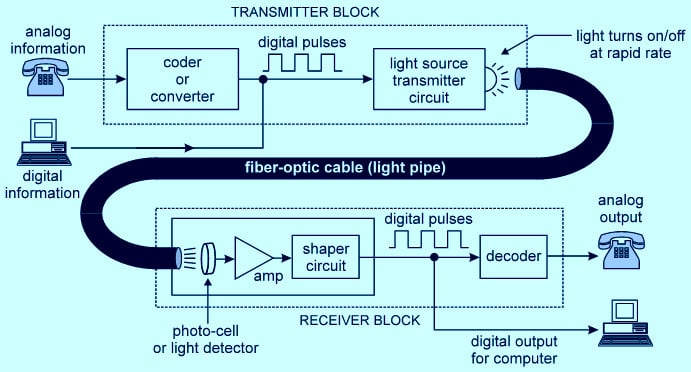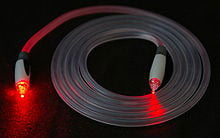
Optical Fiber Communication is the method of communication in which signal is transmitted in the form of light and optical fiber is used as a medium of transmitting those light signal from one place to another. The signal transmitted in optical fiber is converted from the electrical signal into light and at the receiving end, it is converted back into the electrical signal from the light. The data sent can be in the form of audio, video or telemetry data that is to be sent over long distances or over Local Area Networks. Optical fiber communication having good results in long-distance data transfer at high speed, it has been used as an application for various communication purposes.
How do Fiber Optic Communication works?
The Optical fiber communication process transmits a signal in the form of light which is first converted into the light from electrical signals and transmitted, and then vice versa happens on the receiving side.
This process can be explained using a diagram as shown below:

Transmitter side:
On the transmitter side, first if the data is analog, it is sent to a coder or converter circuit which converts the analog signal into digital pulses of 0,1,0,1…(depending on how the data is) and passed through a light source transmitter circuit. And if the input is digital then it is directly sent through the light source transmitter circuit which converts the signal in the form of light waves.
Optical Fiber Cable:
The light waves received from the transmitter circuit to the fiber optic cable is now transmitted from the source location to the destination and received at the receiver block.
Receiver Side:
Now on the receiver side the photocell, also known as the light detector, receives the light waves from the optical fiber cable, amplifies it using the amplifier and converts it into the proper digital signal. Now if the output source is digital then the signal is not changed further and if the output source needs analog signal then the digital pulses are then converted back to an analog signal using the decoder circuit.
The whole process of transmitting an electrical signal from one point to the other by converting it into the light and using Fiber optic cable as transmission source is known as Optical Fiber Communication.
Why Fiber is used?
The fiber wires have replaced the copper wire as transmission cable since it has more advantages than the electrical cables.

- Large Transmission capacity: A single silica fiber can carry hundreds of thousands of telephone channels, utilizing only a small part of the theoretical capacity.
- Small Losses: Approximately 0.2 dB/km signal is lost for modern single-mode silica fibers so that many tens of kilometers can be bridged without amplifying the signals.
- Easy Amplification: A large number of channels can be reamplified in a single fiber amplifier if required for very large transmission distances.
- Low Cost: Due to the huge transmission rate achievable, the cost per transported bit can be extremely low.
- LightWeight: Compared with electrical cables, fiber-optic cables are very lightweight.
- No Interference: Fiber-optic cables are immune to problems that arise with electrical cables, such as ground loops or electromagnetic interference (EMI).
The reasons clearly explain that the fiber optic cables are far better than the coaxial copper cables and this is why Fiber optic cables are preferred over the conventions transmission mediums.
Why light and not Electricity?
Light or Laser light (to be precise) is used for the optical fiber communication because of the reason that the laser light is a single wavelength light source. While the other light signals like sunlight or bulb light have many wavelengths of light and as a result, if used for communication they would produce a beam which is very less powerful and on the other hand, the laser having a single beam would result in a more powerful beam as output.

So, Less Dispersion, transmitting more number of signals & consuming less time makes the light a good source for communication.
Characteristics of Fibre Optic Communication
In Optical fiber communication, light is used as a signal which transmitted inside the optical fiber cable. This mode of communication has characteristics which are important to be discussed and makes it a good mode of communication.
- Bandwidth – Single laser light dispersion means that a good amount of signal can be transmitted (Information being transferred in bits) per second which results in high bandwidth for long distances.
- Smaller diameter – The diameter of Optical fiber cable is about 300 micrometers in diameter.
- Light-weight – The Optical fiber cable is light in weight compared to the copper cable.
- Long-distance signal transmission – Since the laser light doesn’t disperse, it can be easily transmitted over long distances.
- Low attenuation – The fiber is made of glass and laser is traveling through it, the signal transmitted has only 0.2 dB/km loss.
- Transmission security – Optical encryption and no presence of the electromagnetic signal make the data secure over optical fiber.
Applications of Optical Fiber
Optical fiber communication is mainly used in the telecommunication industry which uses the optical fiber for:
- Telephone Signals transmission.
- Internet Communication.
- Cable Television Signal transmission.
Apart from it, optical fibre nowadays, is used everywhere in homes, industries, offices for long distance as well as for small distance communication.
Opotical Fiber Impact on IoT (Internet of Things)
The Fiber Optics Communication will have a great impact on IOT and these things listed will explain to you how IOT would require Fiber Optics.
- Fast Transmission Media - The future will be IOT and all of our devices and things will be connected to the internet, which needs good communication and high speed. The only transmission media that supports such a requirement is Optical Fiber. The future needs IOT and IOT need Optical fiber for best communication that could help reach Wireless data speed up to 100 Gbps speed, making communications and large size data transfer in seconds.
- Data Security – Security in IoT is the main concern when we think of large amount of data to be transferred between billions of devices connected together. Hacking of data from communication media is possible unless it is Optical fiber. The optical fibers are very difficult to hack and hacking them without being detected is like next to impossible. So again, an optical fiber can help secure the data and transfer it at very high speed.
- No data loss due to interference - The optical fiber cables can be installed anywhere (even underwater or at high-temperature areas) and don’t have any electromagnetic interference resulting in no data loss due to interference.





